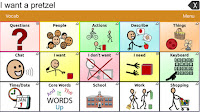At Janey's IEP meeting, I requested she be evaluated by a specialist in AAC (Augmentative and Alternative Communication). She has had access to an iPad with Touch Chat, an AAC program, at school, and we recently got her a new iPad at home and put Touch Chat on it. My main goal with all of this is to find a way to decrease Janey's frustration with what I think is word finding problems---when she knows in her head what she wants to say, but can't find a way to say it. I also just wanted to give her another way to communicate, because although she does talk, her speech is limited.
The consult was done about a week ago, and I got the report this week. It was a good report---thoroughly done, and I felt the woman who did it got a pretty clear picture of Janey's speech as it stands now. Her conclusion? That AAC apps are not something that will help Janey's speech, that in fact, they actually distracted her from communicating functionally.
I was not totally shocked by this conclusion. There's a couple reasons for that. One is that for years, I had sort of thought the same thing. When I had downloaded test versions of several systems like Touch Chat, Janey had no interest, and in fact really seemed to not like the programs. She even said one time, when I said something like "this can help you talk", a very clear statement "I CAN TALK" The other reason is that I have been told through the grapevine that the powers that be in the school system (not the teachers or therapists, but the higher-ups) never want to say kids will benefit from AAC, because then they have to pay for iPads or the like.
However, I have to say I don't think I agree that AAC is not a useful tool for Janey. The main reason the woman evaluating Janey concluded it wasn't is that although she can navigate the system and she show an interest in exploring it, she isn't using it to communicate. My answer there is---Yeah. That's why I would like her to get HELP with using it. It seems like what is being said is something like "She shows she could use it, and she shows an interest, but she doesn't already use it to communicate, so we aren't going to recommend teaching her to communicate with it" That seems like saying "well, this kid has the capacity to read, and is interested in reading, but she doesn't read yet, so we won't teach her" It just doesn't seem to make sense. And isn't exploring a way to learn? When babies learn to talk, not every single utterance is for communication. The tester noted that Janey kept pressing the "stop" and "go" buttons, over and over, without a break. Maybe she was figuring them out? Maybe she wanted to learn them by repetition? Maybe she was just having fun with them, and what is wrong with that?
Also, Janey DID, in the presence of the woman doing the evaluation, communicate with Touch Chat. In the report, she said Janey navigated through a few levels of the application to say "Eat Goldfish Crackers" However, the reports said that the tester didn't have any edibles with her, and it didn't seem to bother Janey, because she didn't seem to be asking for something to eat. Now, just exactly how did the woman doing the test know that? When Janey used the device to say something, why was it assumed she wasn't really saying what she was saying? I do know the impulse to think "She doesn't really mean that". For example, at home, Janey has quite a few times gone through several menus to make Touch Chat say "I don't want to wear white. I want to wear orange" Because Janey has never, even either shown she knows colors or objected to any certain color being worn, my first impulse was to just think she was playing around. But I realized that's a pretty big thing to assume. Maybe Janey never had a WAY to tell me that before. Maybe she really does hate white clothes. Maybe she wants more orange in her wardrobe. No matter what, it seems pretty presumptuous to give someone a way to communicate and then when they do, to assume it means nothing.
To be fair, I really am not sure myself if AAC is going to help Janey with communication, and I don't know if Janey wants to use it or not. After the initial few days with the Touch Chat (and Proloquo) at home, Janey has been rejecting using them, at one point very pointedly by means of hitting me in the face (I made her stay on her bed and not have TV for a while, but I left the Touch Chat out for her in case she wanted to speak ill of me on it!) But I think she deserves a chance.
The good part? Janey's wonderful teacher agrees with me. Today, I sent her new iPad into school, and the teacher is going to update Touch Chat with things like the names of her classmates and with phrases they working on. She is going to continue to make it available at school, and we will continue to make it available at home.
I'm trying not to get discouraged. But at times, I do. It has seemed over the years this same kind of scenario has played out a lot. I am told there's some kind of help available. When I actually decide to try to get that help, it's not actually available in Janey's specific case. This isn't quite like that. Nothing stopped us from getting Touch Chat on our own (and I'm glad we did, because if we had wanted to get it paid for by the schools, we would have been out of luck). We are so, so lucky that Janey has a teacher that believes in her and works closely with us to coordinate our efforts. But still---it feels often like a theme. Janey just doesn't quite fit into any program. She's not "high-functioning", as the music classes we looked into required. Special Olympics, while friendly and welcoming, was not at all aimed at kids like her. And now, her particular combination of being able to talk some and not being instantly inclined to communicate through technology---she isn't quite right for AAC either.
More and more, I realize there just isn't a lot out there to help. And more and more, I appreciate the hands-on school people, the teachers and therapists and aides and all that don't say "she's not quite what we are looking for" but instead just accept her and work with her and love her. And that is what we will keep doing at home, too.







